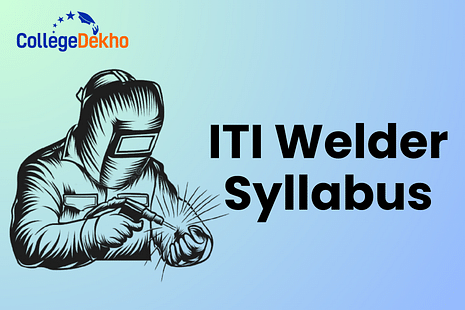
ITI Welder Syllabus : CTS's welding trade program is one of the most popular 1-year courses offered nationwide through a network of ITIs. There are mainly two areas within the ITI Welder Syllabus: the Domain area and the Core area. The Domain area - Trade Theory and Practical - imparts professional skills and knowledge, whereas the Core area - Employability Skill - imparts requisite core skills, knowledge, and life skills.
During this course, as part of the ITI Welder Syllabus under the domain skills, students learn welding types, required tools, welding equipment use, welding material usage, etc. The course provides students with practical training and teaches necessary precautions to implement during emergencies. The ITI welding course also teaches about various welding types with materials like Gas Metal Arc Welding, Gas Tungsten Arc Welding, etc. It also teaches methods of welding joints and different other ways.
Upon successful completion of the training program, the trainee receives the National Trade Certificate (NTC), which is recognised internationally.
Also Read: ITI Admission 2024 (Open)
ITI Welder Syllabus
The ITI welder course syllabus focuses on the basics of welding, such as safety procedures, different types of welding techniques, and the necessary tools for the job. The one-year program focuses on professional skill development, professional knowledge, and employability skills associated with job roles. Additionally, candidates are allowed to develop their confidence through project work and extracurricular activities.
Students can access the Official ITI Welder Syllabus in this Brochure Here - Official ITI Welder Syllabus PDF
Candidates can go through the detailed ITI Welder Syllabus course stated below.
Trade Theory (Professional Knowledge)
Surface Cleaning | Basic Electricity Application | Principle of Arc Welding |
|---|---|---|
Chemistry of Oxy-Acetylene Flame | Arc Welding Power Sources | Metal Arc Welding and Oxy-Acetylene Welding and Cutting |
Gas Brazing & Soldering | Polarity | Importance of Trade Training |
A.C. and D.C. Welding Machines | Electrode | Importance of Welding in Industry |
Classification of Steel | Stainless Steel Types | Welding Methods of Cast Iron |
Safety Precautions in Gas Metal Arc Welding | Types of Welding Joints | Weld Gauges & Their Uses |
Calcium Carbide Properties and Uses | Process of Metal Joining Methods | Hydraulic Back Pressure Valve |
Oxygen Gas and Its Properties | Manifold System | Advantages of GMAW Welding |
Difference between Pipe Welding and Plate Welding | Gas Welding Techniques | ElectroSlag and ElectroGas |
Thermit Welding Process | Gas Regulators | Tungsten Electrodes |
Also Read: Best ITI Courses After 12th in 2024
Trade Practical (Professional Skills)
Deposit Straight Line Bead on M.S. Plate in Flat Position | Edge Joint on MS Sheet 2mm Thick in Flat Position without Filler Rod | Beveling of MS plates 10 mm Thick |
|---|---|---|
Demonstration of Machinery Used in the Trade | Weaved Bead on MS Plate 10mm Thick in Flat Position | Hack Sawing |
Identification of Safety Equipment | Setting up of Oxy-Acetylene and making straight cuts | Circular Gas Cutting on MS Plate 10mm wide by profile cutting machine |
Marking out on M.S. plate and Punching | Fillet Lap Joint on M.S. Plate 10mm Thick in Horizontal Position | Square Butt Joint on M.S. Sheet 2mm Thick in Vertical Position |
Fillet Lap Joint on M.S. Plate 10mm in Vertical Position | Testing of Weld Joints by using Weld Gauges | Square Butt Joint on Aluminium Sheet |
Square Butt Joint on S.S. Sheet | Inspection of Welds by Using Weld Gauges | Pipe Welding |
Square Butt Joint on M.S. Sheet 2 mm Thick in Flat Position | Open Corner Joint on MS Sheet 2 mm Thick in a Flat Position | Square Butt Joint on M.S. Sheet 2mm Thick in Horizontal Position |
Bronze Welding of Cast Iron | Structural Pipe Welding | Setting of Oxy-Acetylene |
Workshop Calculation and Science
Material Science | Ratio and Proportion | Fractions |
|---|---|---|
Basic Algebra | Systems of Unit | Percentage |
Work, Power and Energy | Mass, Weight and Density | Heat and Temperature |
Elasticity | Basic Electricity | Mensuration |
Trigonometry |
Engineering Drawing
Projections | Lines | Free Hand Drawing |
|---|---|---|
Drawing of Geometrical Figures | Drawing Instruments | Dimensioning Practice |
Symbolic Representation used in the Related Trade | Sizes and Layout of Drawing Sheets | Introduction and Its Importance |
Lettering and Numbering as per BIS SP 46-2003 | Drawing of Orthographic Projection in 3rd Angle | Method of Presentation of Engineering Drawing |
Employability Skills
Basics of Computer | Computer Operating System | Listening Skills |
|---|---|---|
Computer Networking and the Internet | Word Processing and Worksheet | Introduction to Communication Skills |
Comparison with Developed Countries | Personal Finance Management | Quality Management System |
Functional Grammar | Reading | Writing |
Speaking/Spoken English | Investment Procurement | Institutions Support |
Concept of Entrepreneurship | Affecting Factors | Motivational Training |
Facing Interviews | Energy Conservation | Quality Consciousness |
Occupational Hazards | First Aid | Benefits |
Quality Tools | Housekeeping | Behavioural Skills |
Global Warming | Ground Water | Environment |
Welfare Acts | Safety & Health | Accident & Safety |
Basic Provisions | Ecosystem | Quality Circles |
ITI Welder Course Eligibility Criteria
Students interested in pursuing a diploma in ITI welding must have at least a class 10th qualification. ITI's welding course eligibility requirements are listed below:
- Passed 10th class from a recognised board or institute.
- Candidates must be able to speak both English and Hindi fluently.
Several universities or colleges conduct the entrance exam for the ITI Welder program. To be admitted to ITI, students must pass their entrance exam and meet the cut-off mark.
ITI Welder Course Duration
Welders at ITI undergo a one-year program in which they are taught various welding components. The following is a breakdown of the classroom hours for the ITI welder course by component:
- Employability Skills: 110
- Engineering Drawing: 129
- Professional Knowledge (Trade Theory): 258
- Professional Skill (Trade Practica): 1075
- Project Work: 80
- Workshop Calculation & Science: 86
- Revision & Examination: 280 hours
- Library & Extracurricular Activities: 62
We hope this article helped you gain insight into the ITI Welder trade syllabus and eligibility criteria. If you have any queries, write to our experts on the CollegeDekho QnA Zone . For personalised assistance with admission to your chosen MBA college, fill out our Common Application Form (CAF) or call our helpline number 1800-572-9877.
Are you feeling lost and unsure about what career path to take after completing 12th standard?
Say goodbye to confusion and hello to a bright future!

FAQs
The highest salary for an ITI welder in India can be around INR 18 lakh, and the average salary for an ITI welder in India is INR 16.5 lakh per year. The typical salary range for an ITI welder in India is between INR 15.3 lakh and INR 18.0 lakh. Salary ranges for ITI welders in India vary widely based on their experience, skillset, and location. Additional benefits, such as health insurance and retirement plans, may also be offered by employers.
Welder training is offered at the ITI for 12 months or 1 year. During this course, as part of the domain skills, students learn welding types, required tools, welding equipment use, welding material usage, etc.
Once students have completed the ITI welding course, they will be able to apply to apprenticeship programs, vocational training programs, or higher education programs. The students can work in various job profiles, such as an Arc Welder, Gas Welder, Assistant, Electric Welder, Fabrician, Pipe Welder, etc.
Class 10th or equivalent is required, an ITI certificate in welding trade from a recognised institute, and one year's experience as an apprentice in any reputable organisation.
Was this article helpful?


















Similar Articles
ITI Admission 2025: State-wise Dates, Online Form, Fees, Merit List, Courses and Fees
West Bengal (WBSCVT) ITI Admission 2025: Registration, Merit List, Choice Filling, Seat Allotment, Fees, Trades
List of Top ITI Colleges in Bihar 2025: Private & Government
Bihar ITI Admission 2025: Dates, Eligibility, Application Form, Admission Process, Counselling
ITI Application Form 2025: Dates, Fee, Registration Process, Official Websites
List of Jobs Available After ITI Computer Operator and Programming Assistant Trade: Job Roles, Salary, ROI